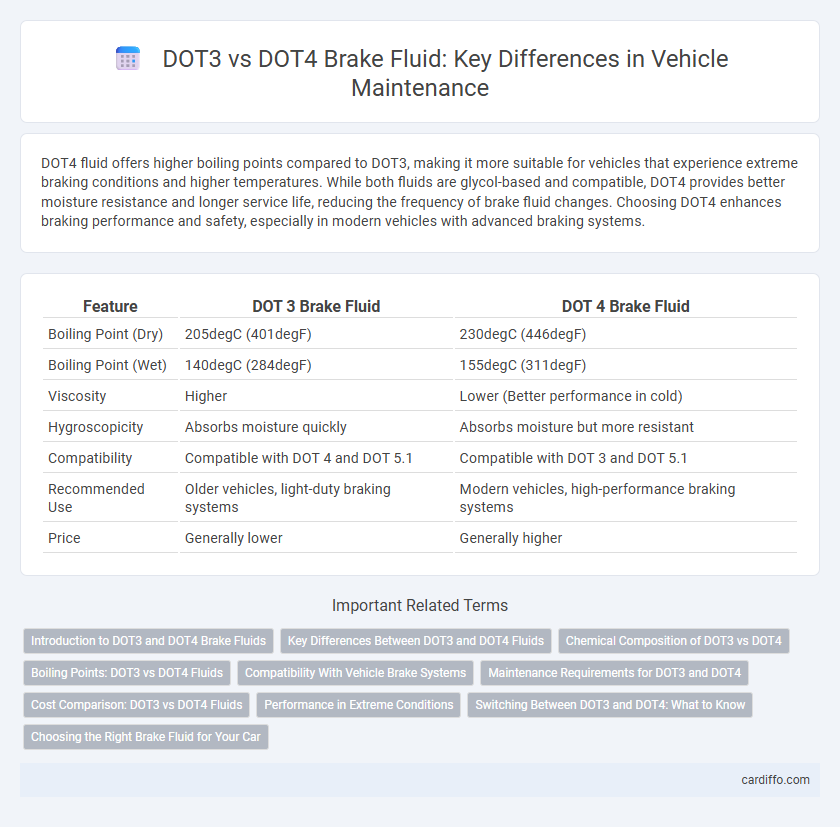DOT4 fluid offers higher boiling points compared to DOT3, making it more suitable for vehicles that experience extreme braking conditions and higher temperatures. While both fluids are glycol-based and compatible, DOT4 provides better moisture resistance and longer service life, reducing the frequency of brake fluid changes. Choosing DOT4 enhances braking performance and safety, especially in modern vehicles with advanced braking systems.
Table of Comparison
| Feature | DOT 3 Brake Fluid | DOT 4 Brake Fluid |
|---|---|---|
| Boiling Point (Dry) | 205degC (401degF) | 230degC (446degF) |
| Boiling Point (Wet) | 140degC (284degF) | 155degC (311degF) |
| Viscosity | Higher | Lower (Better performance in cold) |
| Hygroscopicity | Absorbs moisture quickly | Absorbs moisture but more resistant |
| Compatibility | Compatible with DOT 4 and DOT 5.1 | Compatible with DOT 3 and DOT 5.1 |
| Recommended Use | Older vehicles, light-duty braking systems | Modern vehicles, high-performance braking systems |
| Price | Generally lower | Generally higher |
Introduction to DOT3 and DOT4 Brake Fluids
DOT3 and DOT4 brake fluids are glycol-based hydraulic fluids commonly used in automotive braking systems to transfer force and provide corrosion protection. DOT4 fluid has a higher boiling point compared to DOT3, making it more suitable for modern vehicles that experience higher braking temperatures. Both fluids are hygroscopic, absorbing moisture over time, which necessitates regular maintenance and fluid replacement to ensure optimal braking performance and safety.
Key Differences Between DOT3 and DOT4 Fluids
DOT3 brake fluid has a lower boiling point around 205degC (401degF) compared to DOT4, which typically boils at 230degC (446degF), making DOT4 more suitable for high-performance braking systems. DOT4 fluid contains borate esters that enhance moisture resistance and reduce the risk of brake fade, whereas DOT3 absorbs moisture more readily leading to faster degradation. The compatibility of DOT4 with ABS and electronic stability control systems is superior, providing better overall performance and safety under demanding driving conditions.
Chemical Composition of DOT3 vs DOT4
DOT3 brake fluid primarily consists of glycol ethers, while DOT4 fluid contains a higher concentration of borate esters and glycol ethers, which enhances its boiling point and thermal stability. The chemical composition difference allows DOT4 fluid to perform better under high-temperature conditions, reducing the risk of vapor lock and brake fade. These variations in chemical makeup also affect moisture absorption rates, with DOT4 fluids typically absorbing less water than DOT3 fluids, improving longevity and brake system safety.
Boiling Points: DOT3 vs DOT4 Fluids
DOT4 brake fluid has a higher boiling point compared to DOT3, making it more suitable for vehicles exposed to high temperatures and demanding braking conditions. The wet boiling point of DOT4 fluid generally exceeds 140degC, while DOT3 fluid has a wet boiling point around 140degC, indicating better moisture resistance in DOT4. This difference in boiling points enhances braking performance and reduces the risk of vapor lock in hydraulic brake systems.
Compatibility With Vehicle Brake Systems
DOT3 and DOT4 brake fluids differ primarily in their chemical composition and boiling points, both compatible with most vehicle brake systems but suited for different performance needs. DOT3 fluid, glycol-based with a lower boiling point, is common in older or standard vehicles, while DOT4 fluid, offering higher boiling points and improved moisture resistance, is preferred for modern, high-performance braking systems. Ensuring compatibility involves checking manufacturer specifications, as mixing fluids or using an incompatible type can compromise brake efficiency and safety.
Maintenance Requirements for DOT3 and DOT4
DOT3 brake fluid requires more frequent maintenance due to its lower boiling point and higher moisture absorption rate, necessitating fluid replacement typically every 1 to 2 years. DOT4 fluid offers enhanced performance with a higher boiling point and improved chemical stability, allowing for longer maintenance intervals, often around 2 to 3 years. Both fluids demand proper sealing to prevent moisture contamination, but DOT4's formulation provides greater resistance to degradation under high-temperature conditions.
Cost Comparison: DOT3 vs DOT4 Fluids
DOT3 brake fluid is generally more affordable than DOT4, making it a cost-effective option for standard maintenance. DOT4 fluid, while pricier, offers higher performance with better heat resistance, justifying its cost in demanding driving conditions. Choosing between DOT3 and DOT4 fluids depends on budget constraints and vehicle requirements for optimal braking performance.
Performance in Extreme Conditions
DOT4 brake fluid offers superior performance in extreme conditions compared to DOT3 due to its higher boiling points, with a dry boiling point around 230degC and a wet boiling point near 155degC, significantly reducing vapor lock risk during intense braking. DOT3 fluid, with a dry boiling point near 205degC and wet boiling point around 140degC, is more prone to boiling under high temperatures, potentially compromising braking efficiency. For vehicles exposed to heavy braking or high-performance environments, DOT4 ensures more reliable and stable fluid performance, enhancing overall safety.
Switching Between DOT3 and DOT4: What to Know
Switching between DOT3 and DOT4 brake fluids requires caution due to differences in chemical composition and boiling points; DOT4 fluid has a higher boiling point and contains glycol-ether additives for improved performance. Both fluids are compatible because they are glycol-based, but DOT4 offers better moisture absorption, which can affect brake system longevity. It is essential to fully flush the brake system before switching to prevent contamination and maintain optimal braking performance.
Choosing the Right Brake Fluid for Your Car
DOT4 brake fluid offers a higher boiling point compared to DOT3, making it more suitable for vehicles subjected to intense driving conditions or higher temperatures. DOT3 fluid is compatible with most standard braking systems but may absorb moisture more quickly, requiring more frequent changes to maintain optimal performance. Selecting the appropriate brake fluid depends on your car manufacturer's specifications and driving habits, ensuring effective braking safety and longevity.
DOT3 Fluid vs DOT4 Fluid Infographic

 cardiffo.com
cardiffo.com